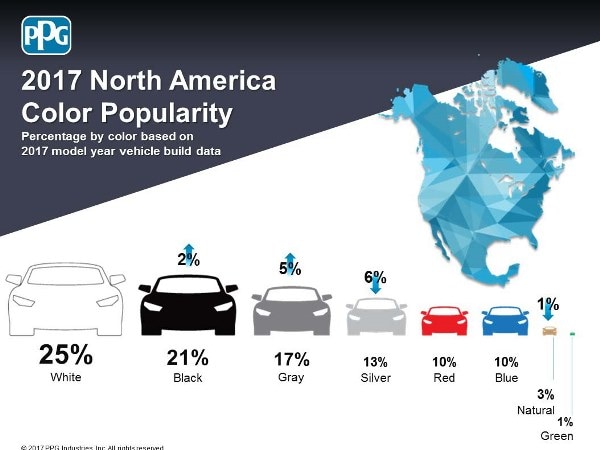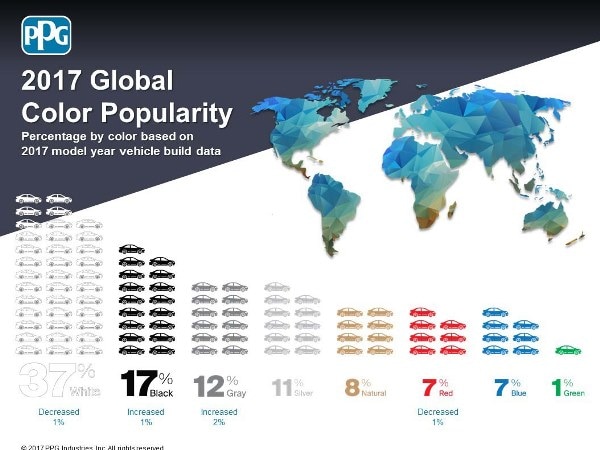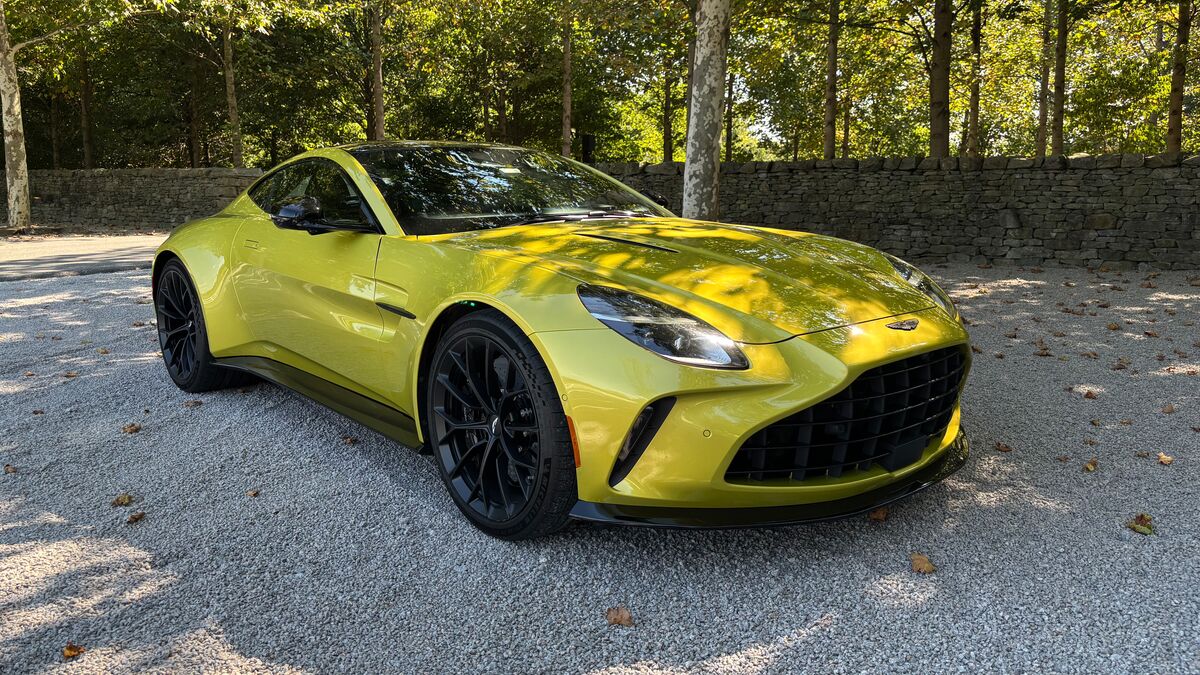Blue was the fastest growing vehicle color in the 2017 model year, but it has a long way to go before topping the No. 1 favorite. While car buyers say color is a major consideration in their buying decision, a global analysis of 2017 model year vehicle colors revealed that an ultra-conservative color ranks as top choice, namely white.
The analysis, which tallied all vehicles produced globally during the 2017 model year, was conducted by PPG, a Pittsburgh-based company that supplies paint and other coatings to the automotive, aerospace, marine and other industries.
Conservative colors rule
The global survey showed that while some automakers touted bright colors on some models in print, internet and television ads, especially in the North America, conservative colors, namely white, black, gray and silver combined account for 77 percent of vehicle-color preference across the world. Globally, white is on 37 percent of all vehicles produced, followed by black with 17 percent; gray, 12 percent; silver, 11 percent; natural (gold, beige, orange and brown hues), 8 percent; red, 7 percent; blue, 7 percent, and green, 1 percent.
As for North American buyers, 25 percent bought a white-colored vehicle in the 2017 model year, followed by black at 21 percent; gray, 17 percent; silver, 13 percent; and red and blue, both at 10 percent. The remaining 4 percent was composed of other colors.
Also: See the 12 Kelley Blue Book Best Buys of 2018
PPG said that similar conservative tone was found in other regions with white leading the way: In Europe, white leads with 32 percent followed by gray, 18 percent; black, 17 percent, and silver, 9 percent. Other colors comprised the remaining 24 percent. In South America, whiten was chosen 38 percent of the time; silver, 31 percent; black, 10 percent; gray, 9 percent, and red, 8 percent. The Asia Pacific market saw white biggest share, 44 percent; with black at 15 percent; silver, 10 percent, and natural, 10 percent.
More blue and brown coming
“PPG’s leading position in paint and color forecasting allows us to analyze cross-cultural and cross-industry trends with our 20 global color stylists from seven countries," said Jane Harrington, PPG manager, automotive color styling. “While we know that automotive color trends are inspired by multiple industries, they are unique compared to fashion or home décor since the trends evolve and change slowly over time instead of significantly year-to-year. While white, black, gray and silver continue to be popular color choices, we are seeing a steady increase in the desire for cars in varying blue and brown shades." PPG data shows that blue vehicles increased 3 percent globally over the previous year and 5 percent among luxury models.
While the PPG data showed that comforting neutrals that are popular in fashion, technology and home colors contribute to silver and gray continuing as popular automotive hues.
Also: Get your first look at the new and redesigned cars of 2019
As for the future, PPG said four themed color palettes will be available to automakers for the 2021 model year:
Retreater: The theme focuses on the need to retreat from the pressures and overstimulation of technology and 24/7 schedules. The colors are earthen tones inspired by stone, marble, sand and clay paired with white and easy pastel shades.
Dream Weaver: This trend is to live loud, pursue pleasure and revel boldly in life, PPG said. Saturated bright colors are offset with high sparkle dark tones. Chromatic layered colors in tinted clears and varying degrees of saturation expand future automotive color options including eye-catching reds, unusual greens and deep oranges.
Commoner: This theme represents simplicity without disengaging from the world. Key colors for this palette are a mix of almost-primary reds, blues, basic white, natural browns and greens.
Brave: Theme represents transformation and strength, a visual reaction to global unrest and uncertainty. This palette integrates opulent jewel tones, such as sapphire, elegant browns and warm neutrals.
Automakers consider everyone from technology-focused millennials to family-focused baby boomers, “monitoring sales data and style trends to try to predict two or three years in advance of a model year what colors and effects they will offer,” Harrington said. “With a full spectrum of colors that can range in appearance from bright sparkle to silky pearlescence, carmakers have an endless variety of options.”









